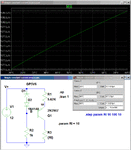neddie
Full Member level 5
- Joined
- Feb 23, 2010
- Messages
- 251
- Helped
- 41
- Reputation
- 82
- Reaction score
- 35
- Trophy points
- 1,308
- Location
- South Africa
- Activity points
- 3,026
Attached is a LTSpice circuit of a simple constant current source. A standard pnp / zener arrangement.
I've used this circuit years ago , but I don't remember it being as good as the simulation
suggests. Set for about 1mA output , it only varies by 25uA with a temperature change from 20 to 80
degrees and a load change from 10 to 100 ohms.
Is spice lying to me :0) When I get home I'll build it and see , just wondering.
Cheers
Neddie
sorry , forgot attachment :0(
I've used this circuit years ago , but I don't remember it being as good as the simulation
suggests. Set for about 1mA output , it only varies by 25uA with a temperature change from 20 to 80
degrees and a load change from 10 to 100 ohms.
Is spice lying to me :0) When I get home I'll build it and see , just wondering.
Cheers
Neddie
sorry , forgot attachment :0(
Attachments
Last edited:
